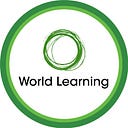The Evolution of Innovation:
World Learning’s latest projects advance girls’ education, online exchanges, and tools for measuring inclusion
By Julienne Gage
There has been a lot of talk in recent years about changing the world through innovation and adaptation, but they’re hardly new concepts. In fact, World Learning has been adapting its international education, exchange and development programs to the latest trends in human interaction and technology for 80 years. This constant evolution means there are always new programs to talk about. This year, World Learning is focusing intensively on virtual exchanges, more accessible education for adolescent girls, and a new research tool that can help policymakers address the needs of people with disabilities.
Let Girls Learn
Statistical evidence suggests that worldwide, increased access to quality education among adolescent girls is key to creating a more peaceful, economically stable society. According to research by the USAID-funded Let Girls Learn initiative, which hopes to lower those barriers, every extra year of education can increase a person’s earnings by 20 percent, and yet, some 62 million girls around the world lack access to any schooling. This translates into all kinds of societal phenomena. In India, for example, educated women are more likely to resist violence, and in Burkina Fasso, mothers of girls receiving a quality education are 40 percent less likely to subject their daughters to female genital mutilation. That’s because education increases the girls’ chances of becoming economically self-sufficient, as well as improves their critical thinking and self-esteem. With this goal in mind, this November, World Learning will facilitate the participation of some 4,000 economically marginalized girls in Pakistan in a USAID/Let Girls Learn vocational and entrepreneurial training program called Pathways to Success.
The Power of Inclusion
Over the past few decades, social scientists and development experts have been able to use these types of gender analytics to identify and empower other marginalized groups such as indigenous peoples, ethnic minorities, people with disabilities and members of the LGBTI community. In fact, World Learning is leading this effort through its Transforming Agency Access to Power or TAAP framework, a systematic tool to design, implement and manage gender and inclusion-sensitive development programs.
Ideally, humans would recognize and respect each other’s rights and dignity, but World Learning program offers find the data makes a difference. Policy makers and ordinary citizens are less likely to consider race, gender, disabilities or sexual orientation as a stigma when they are able to see that inclusion is in their own best interest.
So far, the TAAP tool is showing that people representing one or more of these groups could account for as much as 80 percent of a country’s population. That means social inclusion initiatives could easily become a part of multisector development from infrastructure and urban planning to public health, private sector business, and civic engagement.
Exchanges 2.0
But human rapport building can still change the way groups of people relate to each other, which is why international exchange programs remain a core component of World Learning’s focus, even when limited funds and heightened security risks complicate international travel.
Over the past five years, World Learning’s Iraqi Young Leaders Exchange Program (IYLEP) has brought together hundreds of young people from Iraq and the United States for a month-long leadership training program. Now, thanks to funding from the The Aspen Institute Stevens Initiative, World Learning will launch a virtual IYLEP exchange program to host an additional 300 youth over the internet.
While youth in the online program won’t be able to reach out and shake each other’s hand or share a meal in the home of a host family, they will have ample opportunity to build relationships through moderated internet rapport building games and activities, and World Learning is hopeful these young cyberspace leaders will generate plenty of their own ideas for helping the online program to emulate the traditional people-to-people experience.
